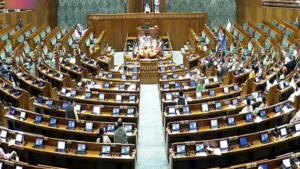India’s Budget session has been extended by a day to allow for the tabling of a “white paper” on alleged economic mismanagement under the previous Congress-led UPA government. Finance Minister Nirmala Sitharaman will present the white paper in both houses of Parliament on Feb 10, highlighting the economic challenges faced before 2014 and the subsequent turnaround under the current government.
What is a White Paper
White papers are formal government documents that present policy proposals, often bound in white covers. They have been used historically to introduce new policies or legislation and gauge public reaction to government initiatives.
A white paper on macroeconomic mismanagement in India would likely be a comprehensive document that analyzes and assesses various aspects of India’s macroeconomic policies, performance, and challenges. It would typically cover a wide range of topics related to the management of the economy at the national level, including fiscal policy, monetary policy, exchange rate policy, trade policy, and structural reforms.
Key components of such a white paper might include
-
Economic Indicators: An overview of key economic indicators such as GDP growth, inflation rate, unemployment rate, fiscal deficit, current account deficit, etc., to provide a snapshot of the overall economic situation.
- Policy Analysis: A detailed examination of the macroeconomic policies pursued by the government and central bank, including their objectives, implementation, effectiveness, and impact on the economy.
- Challenges and Constraints: Identification and analysis of the major challenges and constraints facing the Indian economy, such as structural weaknesses, institutional deficiencies, policy inconsistencies, external vulnerabilities, etc.
- Causes of Mismanagement: Analysis of the factors contributing to macroeconomic mismanagement, such as political interference, policy paralysis, lack of coordination between different government agencies, inadequate institutional capacity, etc.
-
Case Studies: Case studies of specific episodes of macroeconomic mismanagement in India, such as currency crises, inflationary spikes, fiscal slippages, etc., to illustrate key issues and lessons learned.
Significance of a White Paper
The white paper serves as a tool for the government to communicate its analysis of past economic policies and present its vision for the future. It aims to educate the public on economic issues and gather feedback on proposed strategies.
Role
- Policy Introduction: White papers are used to introduce major policy shifts or significant legislation.
- Public Education: They provide detailed explanations of issues and proposed government actions.
- Public Opinion Gauge: They serve to gauge public opinion and reaction to proposed policies or legislation.
Purpose
- Educate the Public: White papers educate citizens about the government’s stance on specific issues and its proposed solutions.
- Test Public Reaction: They provide a platform for the government to gauge public sentiment towards its proposed policies or legislative changes.
- Policy Transparency: White papers promote transparency by outlining government policies and their rationale for public scrutiny.
Caution: It is not an Adda 247’s personal views rather influenced by various government reports and contemporary news!!




 Prime Minister Releases Commemorative Po...
Prime Minister Releases Commemorative Po...
 Parliament Passes SHANTI Bill, AERB Gets...
Parliament Passes SHANTI Bill, AERB Gets...
 Viksit Bharat G RAM G Bill Passed in Lo...
Viksit Bharat G RAM G Bill Passed in Lo...







